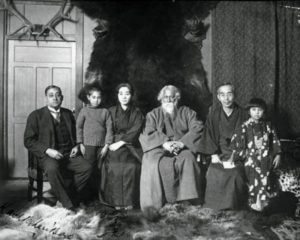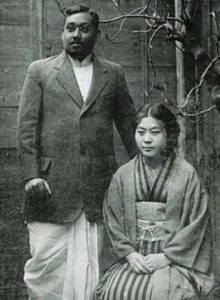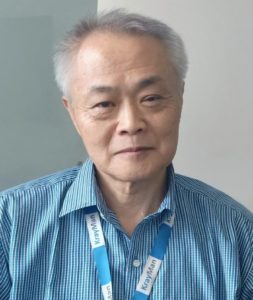The tale of two Boses, their Japanese connect and authentic Indian curry
THE two great Indians – Rash Behari Bose and Subhas Chandra Bose, we Japanese should never forget.
Though both of them shared common family names but came from two distinct states of India. Another commonality between the two was their strong connect with Japan. And both were friends of Japan and were the key forces behind the formation of the Indian National Army (INA), the Azad Hind Fauz, which was floated to free India from the colonial rule of Britain.
And both died in the same year too – in 1945. One in Japan, another in Taiwan.
However, Rash Behari Bose was responsible for introducing authentic Indian curry in the early 1900s in Japan that is served in Tokyo’s popular restaurants even today.
Not many know that Rash Behari Bose (1886 – 1945) was born in the present Indian state of West Bengal while Subhas Chandra Bose (1897-1945) hailed from Odisha state.
Both had close relations with Japan until the end of World War II. They were fighting to contribute to Indian independence from outside India.
About Subhas Chandra Bose, many books were written on his political ideologies, chronologies – both in English as well as the

Japanese language, however, Rash Behari Bose is less known than Subhas Chandra Bose, and remained an unsung hero and a great freedom fighter. He was also decorated with Japan’s top honour: Order of Rising Sun.
In 1912, in Delhi, Rash Behari Bose made a botched attempt to get Lord Hardinge, the then British Viceroy and Governor-General of India, assassinated. After this, Rash Behari Bose had almost gone into hiding in India and after escaping from police hunt with cash bounty on his head, he decided to escape from India and landed in Japan in 1915.
The then British Embassy in Japan, after confirming his arrival of R. B. Bose to Japan, requested Japanese police for his extradition, as Japan and Britain were in the Anglo-Japanese Alliance. British authority doubted about the Bose’s secret relationship with the then German Empire. But in the year 1918, the then German Empire defeated in the 1st World War and Britain had lost the ground to capture R. B. Bose.
Bose remained underground in Japan for about three years as some Japanese Pan Asian movement activists offered him the shelters to hide. Among them, family Soma, known as Nakamura-ya bakery shop in Tokyo, harbored him.
Bose’s stay in the detached house in the inner garden of the Soma family started in 1915. After changing hiding place in Tokyo, he became free from the chase by the police in 1918.
R. B. Bose not only supported India’s Independence movement from the Japanese soil, and formed the Indian Independence League, the precursor of the National Army (INA) but also he strengthened his life base in Japan.

He married Toshiko in 1918, and he acquired Japanese citizenship in the year 1923. Toshiko was the elder daughter of the Soma family, and he, R. B. Bose, also engaged in the management of the Soma family’s Nakamura bakery. He wanted to introduce the real Indian curry or Kari to the menu of the café attached to Nakamuraya.
In Japan, the curry dishes introduced to Japan from Britain were believed to be an authentic Kari (curry), however, it was a modified form of Indian curry which was adjusted to British taste. There might be only a few limited Japanese who knew the variety of real taste and flavor of Indian curry.
For him, R. B. Bose, as one of the freedom fighters devoting to the Indian independence movement, the image of modified European curry introduced to Japan was irritating, I presume. Although his beloved spouse passed away in 1925 due to pneumonia, his enthusiasm continues to spread the Indian culinary spirits.
R. B. Bose’s political movement in Japan became active from around this time.
The stabilized basis for the movement to encourage India’s independence from Japan and Southeast Asia was concentrated in Bangkok in the year 1942. Several groups of patriots in Southeast Asia got together, and this new outfit was later converted into the Indian National Army (INA) with the help of the Japanese Imperial Army.
Although R. B. Bose’s effort continued to conduct the solid unified troops in Asia, his health ruined day by day. The then Japan’s army decided to replace the leadership of INA and Subhas Chandra Bose who was in Germany was picked up for the job. He was trying to support Indian Independence from Britain together with Germany. R. B. Bose welcomed the arrival of Subhas Chandra Bose.
To cure the health condition, R. B. Bose returned to Japan and stayed in Japan for medical treatment. He, however, supported the Independent movement from Japan until he passed away in January 1945 in Tokyo, just before the defeat of Japan in World War II on August 15, 1945. The then Emperor reported to the nation of Japan, the acceptance of the Potsdam Declaration.
On the other hand, Subhash Chandra Bose also passed away reportedly in Taipei on August 18, 1945, in an aircraft crash. In the year, 1947, India became an independent country.
I think both the Bose wanted to achieve Indian independence by entering India from the eastern side. This attempt of Imphal operations failed though.
The path they chose to achieve India’s independence was from the one spearheaded by Mahatama Gandhi whom both of them respected. We should not forget the contribution of both the Bose as their spirit survives even today.
I think, it is better for both the Japanese and Indian young generations to share the background of historical knowledge of the recent past, which can propel the mutual relation meaningfully, not only from the economic, industrial aspects but also from the cultural angle.
Both Bose were hoping that all Asian people can be made independent of the big influential expansionistic political powers. This attitude to maintain freedom for independence is of importance in today’s changing world.
Thank you
N.B. Historical descriptions are mainly based on the 9th edition of the book “Nakamura-ya no Bose” written by Professor Gakushi Nakajima. Published in 2008 with ISBN 978-4-560-02778-3.

[The author of this article Yukihiko YAMADA, is the Japanese national from Hamamatsu city. He has been living and working in India for over a decade, and is M.A. of German literature and linguistics in Japan and Germany. Having worked in Commercial and Investment Banking in European banks and also experienced in manufacturing engineering in JMNC, Yamada is now engaged in the business consulting area. He is representative, Japan Desk of KrayMan Consultants LLP, and is promoting medium and small Japanese companies to come to India. KrayMan Consultants specializes in the field of accounting, taxation and business consulting.]



This is an excellent and engaging account of the contribution made by Rash Behari Bose. Especially the introduction of authentic “kari” in Japan by R.B. Bose is a little known fact in India.
My compliments to Yamada san on a well researched and engaging article.